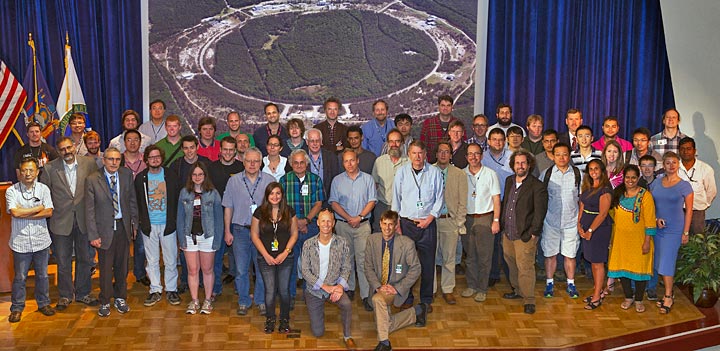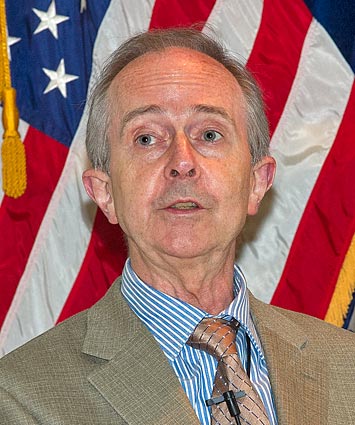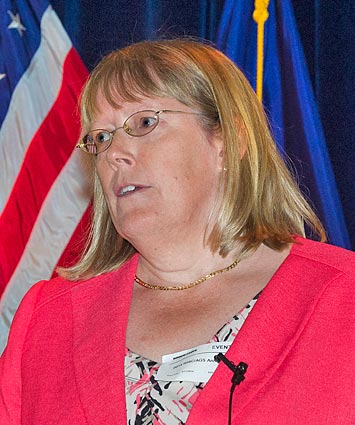A New Look for RHIC & Sharper View of QCD: Looking Back at the 2014 RHIC-AGS Users' Meeting
August 8, 2014
Scientists use the Relativistic Heavy Ion Collider (RHIC) at Brookhaven Lab to re-create the conditions microseconds after the Big Bang, before the "strong" force confined quarks and gluons into the protons and neutrons that make up what's seen in the universe today, nearly 14 billion years later. RHIC and the theory of those strong interactions between quarks and gluons, called quantum chromodynamics (QCD), were the main topics of discussion among nearly 200 scientists from the RHIC and Alternating Gradient Synchrotron (AGS) user communities who trekked to the Lab in late June—some from institutions as far as Europe and Asia—for four days of workshops and sessions during the 2014 users’ meeting, titled “A New Look for RHIC: Sharpening the View of QCD.”
"This meeting is happening at a very opportune time," said Deputy Associate Laboratory Director for Nuclear and Particle Physics David Lissauer, as he welcomed attendees to the first plenary session. "The RHIC experiments added new capabilities to the detectors in the past year, the RHIC luminosity is breaking records and with more gold-gold collisions in this run than the combined total of all previous runs, the experiments have performed remarkably well collecting these record amounts of data, and plans for eRHIC are progressing well."
Highlights From RHIC Run 14
Christoph Montag and Guillaume Robert-Demolaize, both of the Lab's Collider-Accelerator Department, spoke next, giving overviews of Run 14, which began in February and continued until early July. Run 14 included three weeks of gold-gold collisions at 15 billion electron volts (GeV), 14 weeks of gold-gold collisions at 200 GeV, and two weeks colliding gold with the isotope helium-3 at 100 (GeV).
"Nuclear science is going to continue to be an important part of the U.S. science investment strategy for new knowledge, new technology, and supporting U.S. security and competiveness."
— Timothy Hallman, U.S. Department of Energy Office of Science Associate Director for Nuclear Physics
Robert-Demolaize noted that C-AD delivered record-breaking bunch intensities and luminosity—collision rates—to both the PHENIX and STAR experiments during the 200 GeV gold-gold portion of Run 14. Luminosity exceeded the initial design goals for Run 14 by nearly 50 percent, largely due to the high performance of injectors and RHIC’s stochastic cooling system, as well as two electron lenses and a 56-megahertz superconducting radio-frequency cavity that prevent the ions in each collision-bound bunch from spreading out. These upgrades continued increasing achievable luminosities and optics, and were part of a series of upgrades leading to the current "RHIC-II era."
During the STAR report for RUN 14, Flemming Videbaek of the Lab's Physics Department and STAR collaboration discussed two recent detector upgrades: the heavy flavor tracker, a 460-megapixel silicon detector which scientists used to track two different quark "flavors"—charm and beauty—with microns precision, as well as a muon telescope detector, for studies of particles called Charmonium and Bottomonium mesons in gold-gold collisions. Videbaek also noted that STAR collected significant amounts of data, thanks to both the accelerator and detector's solid performances.
Klaus Dehmelt of Stony Brook University and RHIC’s PHENIX collaboration reported that the PHENIX detector also performed well, particularly while collecting its first dataset with the forward silicon vertex tracker, which tracks particles that originate microns away from gold-gold collisions—particles likely to have come from the decay of the particles that contain charm or beauty quarks. Ultimately, PHENIX achieved about 150 percent of its data goal for gold-gold collisions at 200 GeV.
'Where Are We Now? Where Do We Need to Go?'
"RHIC is the premier facility to explore the phases of QCD matter and with the RHIC-II upgrades complete, RHIC is in its prime," Associate Lab Director for Nuclear and Particle Physics Berndt Mueller told attendees during his presentation. "Stochastic cooling, the electron beam ion source, 56-megahertz cavity, and electron lenses have contributed to unprecedented luminosity for unprecedented statistics at RHIC."
Compared to the Large Hadron Collider (LHC) in Europe as well as other accelerators and colliders being developed in Europe and Russia, Mueller explained, RHIC is the only machine that can cover the entire accessible region along the QCD phase boundary. This means RHIC is the right tool for pinpointing the critical value at which quarks and gluons are freed from or bound by the strong force that confines them in protons and neutrons.
Mueller then discussed seven questions scientists will work to address at RHIC, thanks to the unprecedented luminosity achievements. He also provided year-by-year plans leading to 2024 and a proposed electron-ion collider upgrade, called eRHIC. If built, eRHIC would probe the gluon structure of the proton, determine how particles like protons and neutrons emerge from isolated quarks, and study the high-density phase of cold gluon matter.
"If completed, eRHIC would be the most advanced, energy-efficient accelerator in the world," Mueller added.
Comments From DOE, NSF
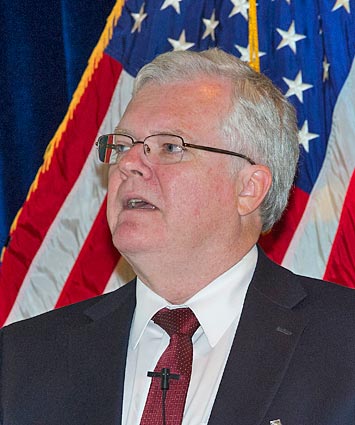 enlarge
enlarge
U.S. Department of Energy Office of Science Associate Director for Nuclear Physics Timothy Hallman
After Mueller's presentation, officials from the U.S. Department of Energy (DOE) and the National Science Foundation (NSF) discussed their organizations’ objectives, achievements, and challenges.
DOE Office of Science Associate Director for Nuclear Physics Timothy Hallman discussed the 2015 presidential budget request for the Office of Science, noting a total request of nearly $593.6 million for nuclear physics in fiscal year (FY) 2015—a $24.4 million increase over the appropriation for FY2014—and an overall upward trend.
"No other facility worldwide, existing or planned, can rival RHIC in range and versatility,” Hallman said. “RHIC is in its prime, it's performing better than ever, and it's continuing to carry out a compelling science program. When scientists decide that something needs further study that they didn't plan on a year ago, they have the flexibility with RHIC to turn on a dime, study that property, and follow their nose as far as where the most compelling science is."
Hallman then highlighted other DOE Office of Science facilities for nuclear physics research before concluding, "Nuclear science is going to continue to be an important part of the U.S. science investment strategy for new knowledge, new technology, and supporting U.S. security and competiveness."
NSF Nuclear Experiment Program Officer Gail Dodge spoke next, explaining that the President's FY15 request included an overall 1.2 percent increase for NSF funding compared with estimates for FY14, but the FY15 allotment for physics would be down one percent with a request for $263.7 million.
"We took a big cut in FY13 and in FY14 it was up a little bit, but we expect next year to be difficult," Dodge said before highlighting NSF's contributions to physics research, as well as proposal and award opportunities for researchers.
Thesis Awards
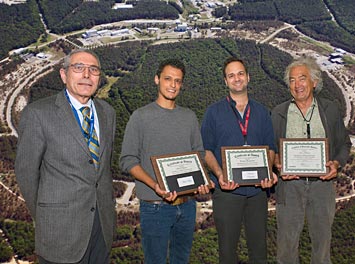 enlarge
enlarge
From left, Deputy Associate Laboratory Director for Nuclear and Particle Physics David Lissauer with two thesis awardees, Ariel Nause of Tel-Aviv University and Dennis Perepelitsa of Brookhaven Lab and Columbia University, and John Harris of Yale University and the STAR collaboration, who accepted Alice Ohlsen's honorable mention on her behalf.
Also during the four-day meeting, Deputy ALD Lissauer presented thesis awards to two Ph.D. students for outstanding research conducted at Brookhaven’s facilities—Ariel Nause of Tel-Aviv University and Dennis Perepelitsa of Brookhaven Lab and Columbia University. Selections were made by a committee appointed by then-Chair of the Users’ Executive Committee (UEC) Mei Bai and were judged on the clarity of their presentation, originality, and physics content. Each honoree received a certificate and a check for $3,000, and both gave presentations on their research.
Nause's thesis is titled "Beating the Shot-Noise Limit: Collective Interaction Optical Noise Suppression in Charged Particle Beam," and he performed an experiment at the Lab's Accelerator Test Facility. The selection committee recognized Nause for demonstrating, "for the first time, suppression of current noise at optical frequencies. This result has important applications for Free Electron Laser technology and may lead to the achievement of temporally coherent outputs."
Perepelitsa's thesis is titled, "Inclusive Jet Production in Ultrarelativistic Proton-Nucleus Collisions." The selection committee honored him for focusing "on jet measurements in deuteron-gold collisions at PHENIX as well as proton-lead collisions as part of the ATLAS experiment at the LHC. The unexpected and remarkable centrality dependence of jet production he discovered at RHIC and subsequently confirmed at the LHC has challenged our previous understandings of geometric effects on hard scattering rates, and it has pointed the community toward new directions for future study."
Alice Ohlsen of Yale University received honorable mention for her thesis, titled "Investigating Parton Energy Loss in the Quark-Gluon Plasma with Jet Hadron Correlations and Jet Azimuthal Anisotropy at STAR."
User Executive Committee Election Results
Before the four-day meeting ended, Paul Sorensen of the Lab's Physics Department and now-Outgoing Chair of the RHIC-AGS UEC announced the UEC election results. The UEC provides an organized avenue for discussion among Lab administration and those who use the Lab's nuclear, high-energy, heavy-ion, radiobiological, and accelerator testing facilities. Joining Sorenson and chair Daniel Cebra of the University of California at Davis, Justin Frantz of Ohio University was voted chair-elect, along with new members Ágnes Mócsy of Pratt Institute, Christine Nattrass of the University of Tennessee, and Christina Swinson of Brookhaven Lab. Daniel McDonald of the University of Houston and Mustafa Mustafa of Lawrence Berkeley National Laboratory were elected student/postdoc representatives.
Outgoing UEC members now include past chair Mei Bai of the Lab's Collider-Accelerator Department and former members Sarah Campbell of Iowa State University; Martin Codrington of the University of Texas at Austin; Cesar Luiz da Silva of Los Alamos National Laboratory; James Rosenzweig of the University of California at Los Angeles; Murad Sarsour of Georgia State University; Anne Sickles, formerly of Brookhaven, now of the University of Illinois at Urbana-Champaign; Jim Thomas of Lawrence Berkeley National Laboratory; and Zhangbu Xu of Brookhaven's Physics Department.
'Glamorous Gluons'
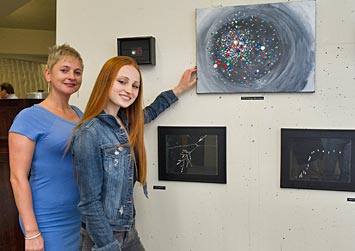 enlarge
enlarge
Artist Sarah Szabo (right) with pieces from her "Glamorous Gluons" collection and mentor Ágnes Mócsy, a theoretical physicist at RHIC and professor at Pratt Institute. See more of Szabo's work.
While members of the RHIC and AGS users communities discussed a sharper view of QCD, they were also treated to a different view of RHIC science during the debut of an art exhibit, called “Glamorous Gluons,” the night before the end of the annual users' meeting. Artist Sarah Szabo, who graduated from Pratt Institute, created the exhibit to visualize RHIC science after learning about physics at Brookhaven from her astronomy professor, Ágnes Mócsy.
2014-5003 | INT/EXT | Newsroom




